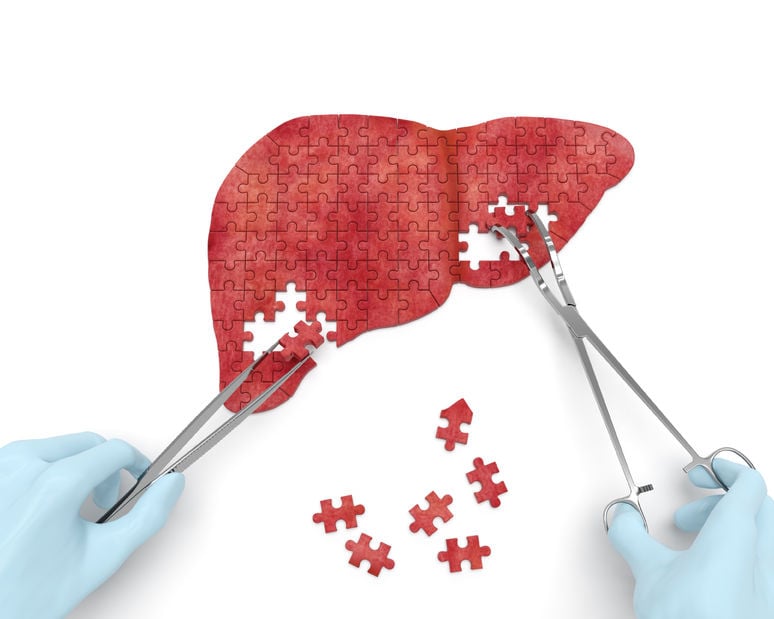As a whole, the United States is becoming more overweight. And as obesity increases across the country, more people are developing a fatty liver as a result. Researchers believe that liver fat, rather than belly fat, is the main indicator for a lot of different health problems, including cardiovascular disease, diabetes and others.1 While the bad news is a lot of us are storing far too much fat in our livers, the good news is that the condition can be reversed.
How the Liver is Supposed to Work
The liver is located just above the stomach, in the upper right hand portion of the abdominal cavity. It’s an incredibly important organ, performing somewhere around 500 functions that are critical to maintaining our overall health. Two of the more vital functions include processing the fat we take in through our diet as well as producing HDL, or “good” cholesterol. In addition, the liver produces bile, which is then stored in the gallbladder. Bile works by breaking down the fat we eat into tiny molecules so we can digest it.
These are just some of the other jobs the liver performs:
· Assisting in the clotting of blood
· Controlling our supply of amino acids
· Helping us process medications we take
· Eliminating toxins produced by those medications
· Producing substances that help the body fight infections
· Storing excess sugars
There are a lot of contributing factors to liver issues, including obesity, alcoholism, certain medications, excessive levels of triglycerides in the blood and several others
What is Fatty Liver?
The body stores most of its fat under the skin, which is also known as subcutaneous fat. Only about 10 percent of the fat in the body is belly fat, with the rest found in muscle tissue and organs such as the liver.
Most of us associate liver disease with drinking too much alcohol, but non-drinkers who are overweight are at a risk of developing liver problems as well. As many as 20 percent of people in the U.S. could potentially have an issue known as non-alcoholic fatty liver disease.2 While having fat in the liver isn’t particularly dangerous, if there’s an abnormal accumulation of fat, that can be a problem.
For example, too much fat in the liver can increase insulin resistance in the body, which can lead to diabetes. Insulin resistance is dangerous because it affects the body’s ability to regulate the amount of glucose in the blood. Glucose is an essential substance that provides energy to our cells. If someone has insulin resistance, however, the cells aren’t able to absorb glucose. As a result, it stays in the blood and greatly increases the risk of diabetes.

Studies about Liver Fat
One study performed by nutrition researchers showed that liver fat is a more reliable indicator of metabolism problems – ones that can lead to diabetes – than belly fat. Researchers compared the amount of liver fat in a group of obese people and found that the ones who had greater concentrations were at a higher risk of developing insulin resistance.
They also found that people with fatty liver issues had lower levels of a protein known as CD36 in their fat tissue, and higher amounts of the protein in their muscle tissue. This is significant, because the researchers believe that CD36 moves fatty acids from fat tissue and into the tissues of the liver as well as muscles. These proteins are then converted to triglycerides, which are a form of fat. The more fatty acids that get into the tissue, the greater the chance for developing metabolic issues.3
Other Issues Associated With Fatty Liver
A fatty liver can also lead to a greater risk of heart problems. When there’s too much unprocessed fat in the liver, it can enter the bloodstream and clog arteries, increasing the chances of a stroke or a heart attack. An excess of fat can lead to several other health issues as well.
Fatty liver disease can also result in inflammation due to the accumulation of fat molecules inside the cells of the organ. This is a form of non-alcoholic fatty liver disease that is even more dangerous, and it is known as non-alcoholic steatohepatitis (NASH).
This condition will typically develop gradually, over several years or even several decades. Some people with NASH might not ever develop symptoms, while others suffer serious problems. For example, NASH often results in fibrosis, a mild scarring of the liver that occurs when the organ tries to regenerate in response to the condition. When scarring becomes severe it becomes a condition known as cirrhosis, which is even more serious.
These are just a few of the symptoms associated with cirrhosis:
· Hardening of the liver
· Intestinal bleeding
· Liver cancer
· Liver failure
· Muscle loss
· Retention of body fluid
Who is at Risk for NASH
NASH will typically affect overweight and obese people age 40 and older, but there is conflicting evidence as to how often the condition turns into cirrhosis. Some studies show that only about 3 percent of people with NASH develop cirrhosis, while others show that up to 26 percent of patients develop the disease.4 Unfortunately, there’s no way that a doctor can predict whether or not NASH will eventually lead to cirrhosis. What is known, however, is that someone with NASH has a much better outlook than someone who develops steatohepatitis due to excessive consumption of alcohol, a condition known as alcoholic steatohepatitis.
The more serious threats posed by NASH could actually be stroke and heart disease rather than further liver damage. The New England Journal of Medicine published an article suggesting that inflammation associated with fatty liver could play a role in causing atherosclerosis, or hardening of the arteries. This is a condition that often leads to the development of blood clots that can result in a stroke or heart attack.
The article referenced a study that showed people who have NASH are two times more likely to die from a stroke or heart attack than people who don’t have the condition. In addition, NASH may also make it riskier to be overweight. Obese people with NASH, according to the article, have higher levels of fibrinogen, which makes the blood more prone to clotting. They also have higher levels of C-reactive protein, which has been linked to inflammation.5

What Happens When the Liver Doesn’t Function Properly?
Ironically, NASH and other conditions associated with fatty liver disease can actually lead to weight loss. Other symptoms linked to liver problems include fatigue, abnormally colored bowel movements, nausea, abdominal pain and others.
If fatty liver develops into NASH, you might notice a sudden loss of appetite as well as vomiting and nausea. Other indications include yellowing of skin and eyes and severe pain in the upper abdominal area.
Diagnosing Fatty Liver Disease
Someone with a fatty liver will often times not show any symptoms, even if fatty liver disease turns into non-alcoholic fatty liver disease or even NASH. They might sense a dull ache in the upper portion of the abdomen or feel fatigued, but that’s about it. In the majority of instances, fatty liver disease or NASH are discovered basically by accident during a blood test.
This test might show that a person has a higher liver enzyme levels than normal, which would then necessitate further testing. One method often used is an ultrasound image test, which is usually used to monitor the development of a fetus. When an ultrasound takes a picture of the liver, fatty liver disease shows up as bright white spots. A CT scan can also be used to take an image of the liver.
However, both ultrasound and CT scans have limitations when it comes to making a diagnosis of fatty liver problems or NASH. The reason is that while the fat will show up in the image, inflammation associated with NASH will not. There are other tests in development that use a combination of blood tests, liver enzyme readings, inflammation markers and certain hormones to help produce a reliable diagnosis, but these are all in the very early stages.
The only truly reliable method to diagnose fatty liver problems such as NASH is to take a biopsy of a portion of the organ. In a biopsy procedure, a surgeon will insert a long needle into the liver and extract a small piece. The doctor will then place the piece under a microscope for examination. As you would expect, a liver biopsy is considered an invasive surgical procedure, and as such comes with the risk of complications. But technology has progressed to the point to where a patient can go home the same day in most cases.
There are a lot of factors that will go into determining whether a doctor will recommend a biopsy to check for fatty liver or other problems. The most important ones are whether the person is showing signs of liver trouble, is obese or has diabetes.
What You Can Do About Fatty Liver
As a result of the uncertainty surrounding the effectiveness of certain medications to treat fatty liver, most experts believe that weight loss is the best way to address this problem. Weight loss through increased exercise and changes in diet can result in a substantial reduction in the amount of fat in the liver. However, it’s very important that patients avoid any sort of crash dieting, because immediately losing weight can actually hurt the liver.6
Instead, follow a sensible plan to help reverse the damage that fatty liver can do. Whatever your strategy may be – either through exercise alone, a combination of physical activity and diet or surgery – it will be critical that you find the weight loss program that works best for you and stick with it.
Scientific studies show exactly how effective a weight loss program can be when it comes to reducing fatty liver. In one study, researchers found that obese people who consumed 500 fewer calories a day than normal lost an average of 8 percent body weight, leading to a substantial reduction in fat accumulation in the liver.7 According to the results of another study, it appears that reduction in both liver fat as well as insulin resistance can be sustained even if a person regains a portion of the weight he or she lost.
Dietary Fixes
Another way to reduce fatty liver is to reduce your intake of carbohydrates – specifically refined carbohydrates. According to research, only a small percentage of fat (16 percent) of liver fat in people who have non-alcoholic fatty liver disease comes directly from their food. Almost 30 percent of that fat accumulates due to de novo lipogenesis (DNL), a process in which the body converts excess carbohydrates into fat. 8 The more high-fructose beverages and foods you consume, the higher the rate at which DNL occurs. 9
Research also shows that people who consume a “Mediterranean diet” (which is primarily high in plant-based foods, nuts, whole grains and “good” fats such as those found in canola and olive oil) tend to lose more liver fat than those who follow a diet high in carbohydrates and low in fats.10

See Your Doctor
Whether or not you have a reason to believe you have a fatty liver, you should see your doctor on a regular basis for a checkup. Periodic blood tests can give you an indication that you might have an issue that needs to be further explored. But even if you’re diagnosed with fatty liver disease or even NASH, just remember that your prognosis should be good if you follow a sensible, safe diet plan.
For more tips on having a healthy, well-balanced life, keep reading here:
Boswellia Serrata Extract – Reduce Pain with Tree Sap?
The Healing Power of Turmeric (+ 2 recipes to get more in your diet!)
Sources:
1.https://www.ncbi.nlm.nih.gov/pubmed/19706383
2.http://www.health.harvard.edu/diseases-and-conditions/when-the-liver-gets-fatty
3.https://www.ncbi.nlm.nih.gov/pubmed/19706383
4.http://www.health.harvard.edu/diseases-and-conditions/when-the-liver-gets-fatty
5.https://pdfs.semanticscholar.org/590d/7084f2176d449028452649ff4300387b3441.pdf
6.http://www.health.harvard.edu/diseases-and-conditions/when-the-liver-gets-fatty
7.https://www.ncbi.nlm.nih.gov/pubmed/23273500
8.https://www.ncbi.nlm.nih.gov/pubmed/15864352
9.https://www.ncbi.nlm.nih.gov/pmc/articles/PMC5027077
10.https://www.ncbi.nlm.nih.gov/pubmed/23485520

Touche. Great arguments. Keep up the amazing effort.
asmr 0mniartist
Hey there! This is kind of off topic but I need some help from an established blog.
Is it tough to set up your own blog? I’m not very techincal but I can figure things out pretty quick.
I’m thinking about creating my own but I’m not sure where to start.
Do you have any points or suggestions? Many thanks asmr 0mniartist
If some one wants expert view concerning running a blog after that i
advise him/her to pay a visit this weblog, Keep up the fastidious work.
0mniartist asmr